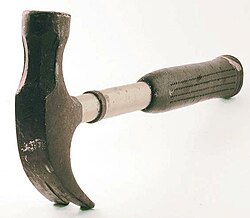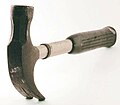Hammer

A hammer is a tool meant to deliver blows to an object. The most common uses are for driving nails, fitting parts, and breaking up objects. Hammers are often designed for a specific purpose, and so their design varies quite a lot. Usual features are a handle and a head, with most of the weight in the head. The basic design is hand-operated, but there are also many mechanically operated models for heavier uses.
The hammer is a basic tool of many professions, and can also be used as a weapon. Either way, it is perhaps the oldest human tool, perhaps even older than the earliest Homo species.
By analogy, the name hammer has also been used for many mechanical parts and devices that are designed to deliver blows, e.g. in the caplock mechanism of firearms.
Basic design and variations
The essential part of a hammer is the head, a compact solid mass that is able to deliver the blows to the intended target without itself breaking up.
The opposite side of the head may have a second striking surface; or a claw or wedge to pull nails, or may be shaped like a ball as in the ball-peen hammer and the cow hammer. Some upholstery hammers have a magnetized appendage, to pick up tacks. In the hatchet the hammer head is secondary to the cutting edge of the tool.
Popular hand-powered variations include-
- carpenter's hammers (used for nailing), such as the framing hammer and the claw hammer
- upholstery hammer
- construction hammers, including the sledgehammer
- drilling hammer - a lightweight, short handled sledgehammer
- ball-peen hammer, or mechanic's hammer
- cross-peen hammer, or Warrington hammer
- mallets, including the rubber hammer and dead blow hammer.
- maul
- stonemason's hammer
- Geologist's hammer or rock pick
- lump hammer, or club hammer
- gavel, used by judges and presiding authorities in general
Mechanically-powered hammers often look quite different from the hand tools, but nevertheless most of them work on the same principle. They include:
- jackhammer
- steam hammer
- hammer drill, that combines a jackhammer-like mechanism with a drill
In professional framing carpentry, the hammer has almost been completely replaced by the nail gun. In professional upholstery, its chief competitor is the staple gun.
Applications and technique
This article contains instructions, advice, or how-to content. |
Avoiding bent nails
When driving a nail, the hammer must be manoeuvered so that its flat face strikes the nail's head at a right angle to the nail's axis, with the head moving parallel to that axis. Failure to achieve either condition will result in a sideways force on the nail's head, that may bend it. Also, one should relax the muscles of the hand and arm momentarily when the hammer strikes.
Consistently driving nails without bending them is a matter of simple, repetitive practice. However, keeping in mind that your objective is to get the weighted hammer head moving at a right angle to the nail head helps. Your arm and hand should be removed as much as possible from the interaction of forces at the moment the head hits the nail, allowing a clean transfer of energy on one directional axis. Taking time to get your body into optimum position helps, too. Relax, take time to get a ladder if you need it; climb down your ladder and move it if you need to change position -- don't wait until your nail is half-bent and you are frustrated!
Nails heat up with friction in the material and impact from the hammer -- and bend more easily when warm -- so the quicker you drive them, the better. A good goal would be one stroke to set the nail, two to drive and one to finish or 'set' the head. No matter how well aimed, lots of weak strokes risk heating the nail, and increase the chance that small variations in the material being nailed will deflect the small forces being delivered, causing the nail to bend. A fast-moving, heavy hammer head will penetrate small variations in the material and drive the nail straight through them.
The physics of hammering
Hammer as a force amplifier
A hammer is basically a force amplifier, that works by converting mechanical work into kinetic energy and back.
In the swing that precedes each blow, a certain amount of kinetic energy gets stored in the hammer's head, equal to the length D of the swing times the force f produced by the muscles of the arm and by gravity. When the hammer strikes, the head gets stopped by an opposite force coming from the target; which is equal and opposite to the force applied by the head to the target. If the target is a hard and heavy object, or if it is resting on some sort of anvil, the head can travel only a very short distance d before stopping. Since the stopping force F times that distance must be equal to the head's kinetic energy, it follows that F will be much greater than the original driving force f—roughly, by a factor D/d. In this way, great strength is not needed to produce a force strong enough to bend steel, or crack the hardest stone.
Effect of the head's mass
The amount of energy delivered to the target by the hammer-blow is equivalent to one half the mass of the head times the square of the head's speed at the time of impact (). While the energy delivered to the target increases linearly with mass, it increases geometrically with the speed (see the effect of the handle, below). As hammers must be used in many circumstances, where the position of the person using them cannot be taken for granted, trade-offs are made for the sake of practicality. Clearly, in areas where one has plenty of room, a long handle with a heavy head (like a sledge hammer) can deliver the maximum amount of energy to the target. But clearly, it's unreasonable to use a sledge hammer to drive upholstery tacks. Thus, the overall design has been modified repeatedly to achieve the optimum utility in a wide variety of situations. Recently, modifications have also been made with respect to the effect of the hammer on the user. Handles made of new, shock-absorbing materials, and heads with different angles, attempt to make it easier for the user to continue to wield this age-old device, even as nail guns and other powered drivers encroach on its traditional field of use.
Effect of the handle
The handle of the hammer helps in several ways. It keeps the user's hands away from the point of impact. It provides a broad area that is better-suited for gripping by the hand. Most importantly, it allows the user to maximize the speed of the head on each blow. The primary constraint on additional handle length is the lack of space in which to swing the hammer. This is why sledge hammers, largely used in open spaces, can have handles that are much longer than a standard carpenter's hammer. The second most important constraint is more subtle. Even without considering the effects of fatigue, the longer the handle, the harder it is to guide the head of the hammer to its target at full speed. Most designs are a compromise between practicality and energy efficiency. Too long a handle: the hammer is inefficient because it delivers force to the wrong place, off-target. Too short a handle: the hammer is inefficient because it doesn't deliver enough force, requiring more blows to complete a given task.
War hammers
The concept of putting a handle on a weight to make it more convenient to use may well have led to the very first weapons ever invented.[citation needed] The club is basically a variant of a hammer. In the Middle Ages, the war hammer became popular when edged weapons could no longer easily penetrate some forms of armour.
Symbolic hammers
The hammer is associated with West Ham United, who are nicknamed 'The Hammers' and have a symbol of two crossed hammers on the team crest. The origin of this goes back to the club's beginning in the 19th Century, when the Thames Ironworks company football team turned professional in 1895, and became renamed as West Ham United.
The hammer, being one of the most used tools by Homo Sapiens, has been used very much in symbols and arms. In the middle ages it was used often in blacksmith guild logos, as well as in many family symbols. The most recognised symbol with a hammer in it is the Hammer and Sickle, which was the symbol of the former Soviet Union. The hammer in this symbol represents the industrial working class (and the sickle the agricultural working class). The hammer is used in some coat of arms in (former) socialist (or pseudo socialist) countries like East Germany.
In Norse Mythology, Thor, the god of thunder and lightning, wields a hammer named Mjolnir. Many artifacts of decorative hammers have been found leading many modern practitioners of this religion to often wear reproductions as a sign of their faith.
In the 1982 film Pink Floyd The Wall, a circular logo featuring two crossed hammers was used on armbands, flags, and banners during the fascist rally scene. These hammers were also featured in the famous "marching hammers" animation loop and the video for "Another Brick in the Wall (Part II)".
The song If I Had a Hammer has been a top ten hit and was considered an anthem of the Civil Rights Movement. It has been recorded by many artists, including Peter, Paul, and Mary, Trini Lopez, and Leonard Nimoy. The song begins:
- If I had a hammer I'd hammer in the morning
- I'd hammer in the evening all over this land
- I'd hammer out danger, I'd hammer out warning
- I'd hammer out love between my brothers and my sisters
- All over this land
In ultimate frisbee, the hammer is a commonly used overhead throw that is thrown vertically and turns over to land upside down horizontally.
Hammers in popular culture
The use of a hammer to fix broken machinery is jokingly referred to as percussive maintenance.





